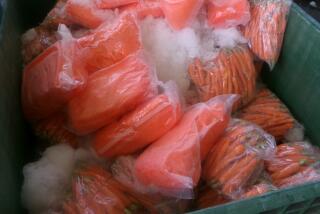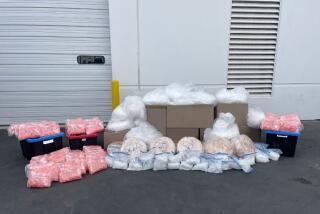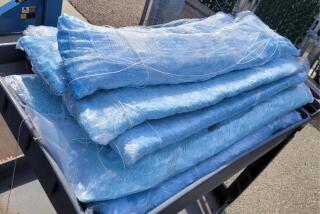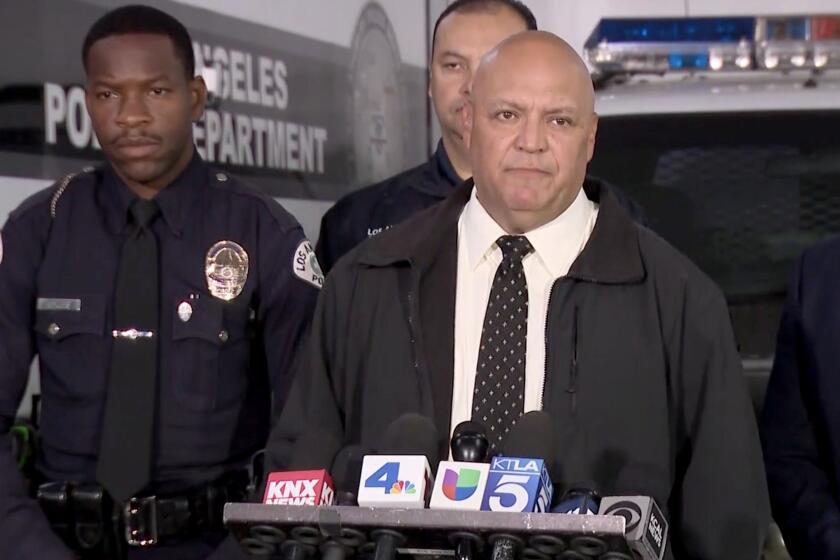Meth entering U.S. mainly through California, report says
California has emerged as the major gateway for methamphetamine into the country, with Mexican organized crime groups smuggling an estimated 70% of the U.S. supply through state border crossings, according to a report released Thursday by state Atty. Gen. Kamala D. Harris.
The 98-page report on trends in transnational organized crime also cites maritime smuggling, money laundering and criminal alliances between Mexican drug cartels and Southern California gangs as growing public safety threats.
The report’s release comes at a time of severe budget cuts at the state Department of Justice. In 2012, the Bureau of Narcotics Enforcement was shuttered, dropping the number of state-led drug task forces from 55 in 2011 to 17 in 2013. More than 60 agents were laid off, according to state officials.
The report — “Gangs Beyond Borders: California and the Fight Against Transnational Organized Crime” — calls for more funding and for the passage of tougher laws, modeled on federal laws, that target organized crime groups.
Federal agencies such as the Drug Enforcement Administration spearhead most anti-drug enforcement operations at the border, but state and local agencies have provided key support in recent years.
“State and local law enforcement officers are on the front lines of this fight every day,” Harris said. “Our response must include sustained funding for their work and strong coordination at all levels of government.”
One of the report’s major findings involves the surge of methamphetamine smuggling across the California-Mexico border. The amount seized at the San Diego ports of entry tripled between 2009 and 2013, to more than 6,000 kilos, or 13,200 pounds. By comparison, about 1,000 kilos, or 2,200 pounds, were seized at border crossings in South Texas in 2013.
California’s sharp increase is probably related to the rise of the Sinaloa drug cartel as the dominant organized crime group in Baja California, according to the report. The organization imports the precursor chemicals from China and India, refines the drug at superlabs in Mexico, then ships it across in vehicles into San Diego.
With many other Mexican border regions still plagued with cartel violence, Baja California provides a relatively tranquil staging area for Sinaloa-affiliated traffickers to move their drugs.
“They are the strongest players in Mexico right now and their trafficking routes come through California,” said Ami Carpenter, an assistant professor at the University of San Diego who contributed research to the report.
In a worrisome trend, state officials said that in some cases the drug is being further refined in labs in rural areas of California.
The report also calls for the creation of a multi-agency task force to stem the sharp increase in maritime smuggling. Using small but swift panga boats, Mexican smugglers in recent years have been taking to the seas to smuggle mostly marijuana onto California beaches.
Marijuana seizures from pangas increased from 3,800 pounds in 2008 to 120,000 pounds in 2012, according to the report. Most landings are on Southern California beaches, but some smugglers have reached as far north as Santa Cruz County, where two boats carrying marijuana were discovered last year.
In an effort to improve cross-border cooperation, Harris next week will lead a delegation of state attorneys general to Mexico City. The delegation is scheduled to meet with several high-ranking Mexican law enforcement officials, including the state attorney general of Baja California.
More to Read
Start your day right
Sign up for Essential California for news, features and recommendations from the L.A. Times and beyond in your inbox six days a week.
You may occasionally receive promotional content from the Los Angeles Times.







